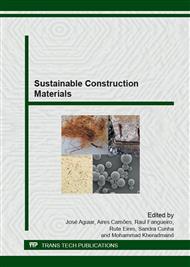[1]
A. Petek Gursel, Eric Masanet, Arpad Horvath, Alex Stadel. Life-cycle inventory analysis of concrete production: A critical Review. Cement & Concrete Composites (2014).
DOI: 10.1016/j.cemconcomp.2014.03.005
Google Scholar
[2]
Bogdan Cazacliu, Anne Ventura. Technical and environmental effects of concrete production: dry batch versus central mixed plant. Journal of Cleaner Production 18 (2010) 1320e1327.
DOI: 10.1016/j.jclepro.2010.04.022
Google Scholar
[3]
IEA, WBCSD, Cement Technology Roadmap 2009 - Carbon emissions reductions up to 2050, in, International Energy Agency [IEA], World Business Council for Sustainable Development [WBCSD], Paris, France, (2009).
DOI: 10.1787/9789264088061-en
Google Scholar
[4]
Mohammed Seddik Meddah, Mukesh C. Lmbachiya, Ravindra K. Dhir . Pcotential use of binary and composite limestone cements in concrete production. Construction and Building Materials 58 (2014) 193–205.
DOI: 10.1016/j.conbuildmat.2013.12.012
Google Scholar
[5]
Gonçalves, J., P., Using the cutting granite waste (RCG) as addition to producing concrete, Federal University of Rio Grande do Sul, postgraduate program in Civil Engineering, Brazil, (2000).
Google Scholar
[6]
Mármol I, Ballester P, Cerro S, Monrós G, Morales J, Sánchez L. Use of granite sludge wastes for the production of colored cement-based mortars. Cem Concr Compos (2010).
DOI: 10.1016/j.cemconcomp.2010.06.003
Google Scholar
[7]
Ho DWS, Sheim AMM, Tam CT. The use of quarry dust for SCC application. Cem Concr Res 2002; 32: 505–11.
Google Scholar
[8]
Abukersh, S. A., & Fairfield, C. A. Recycled aggregate concrete produced with red granite dust as a partial cement replacement, Construction and Building Materials; (2011).
DOI: 10.1016/j.conbuildmat.2011.04.047
Google Scholar
[9]
Felixkala, T., Partheeban. Granite powder concrete. Indian Journal of Science and Technology. Vol. 3, No. 3, March (2010).
Google Scholar
[10]
Ilangovana, R., Mathendrana, N., Nagamanib, K. Strength and durability properties of concrete containing quarry rock dust as fine aggregate. ARPN Journal of Engineering and Applied Sciences. VOL. 3, No 5, October (2008).
Google Scholar
[11]
Ho DWS, Sheim AMM, Tam CT. The use of quarry dust for SCC application. Cem Concr Res 2002; 32: 505 - 11.
Google Scholar
[12]
National Institute of Engineering Technology and Innovation, I. P: http: /rop. ineti. pt/rop/FormProduto. php?idProduto=72 , 12-(2011).
Google Scholar
[13]
IPQ. NP 4220: 2010. Pozzolan for concrete, mortar and grout. Definitions, requirements and conformity assessment. Lisbon, (2010).
Google Scholar
[14]
NP EN 196-1. Methods of testing cement – Part 1: Determination of strength. Lisbon: IPQ; (2006).
Google Scholar
[15]
ASTM. ASTM C 618 standard specification for coal fly ash and taw or calcined natural pozzolan for use in concrete. Philadelphia: (2012).
DOI: 10.1520/c0618-00
Google Scholar
[16]
ASTM C 109/C109-11a. Standard test method for compressive strength of hydraulic cement mortars (using 2 in. or [50 mm] cube specimens). West Conshohocken, (2011).
DOI: 10.1520/c0109_c0109m-20
Google Scholar
[17]
ASTM C 230/C230-08 standard specification for flow table for use in test of hydraulic cement. Philadelphia; (2008).
Google Scholar
[18]
ASTM. ASTM C 1567-11 standard test Method for determining the potencial Alkali–Silica reactivity of combinations of cementitious materials and aggregate (Accelerated Mortar-Bar Method). United States: ASTM International; (2011).
DOI: 10.1520/c1567-08
Google Scholar
[19]
LNEC. E-463: Chloride migration coefficient from non-steady-state migration experiments. Lisbon, (2004).
Google Scholar
[20]
Talero R, Trusilewicz L, Delgado A, Pedrajas C, Lannegrand R, Rahhal V, et al. Comparative and semi-quantitative XRD analysis of Friedel's salt originating from pozzolan and Portland cement. Constr Build Mater 2011; 25: 2370–80.
DOI: 10.1016/j.conbuildmat.2010.11.037
Google Scholar
[21]
<http: /ciks. cbt. nist. gov/'garbocz/nistir6399/node22. htm>; October (2012).
Google Scholar
[22]
St John DA, Poole AW, Sim I. Concrete Petrography: a handbook of investigative techniques. ARNOLD; (1998).
Google Scholar


